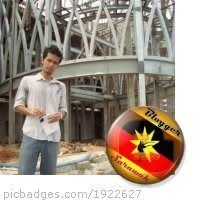The largest group of rural dwellers in traditional  survive the onslaught of modern influences. The traditional animistic religion permeated many aspects of life, frequently even among Christians and Muslim alike.
survive the onslaught of modern influences. The traditional animistic religion permeated many aspects of life, frequently even among Christians and Muslim alike.  The cultivation of the hill rise was the main activity for inland peoples and migration in search of virgin land was common, especially among the Ibans. Indeed, migration was the manor force impelling this energetic people, the largest of Dayak groups, from their older settlements in the upper Batang Lupar across the face of
The cultivation of the hill rise was the main activity for inland peoples and migration in search of virgin land was common, especially among the Ibans. Indeed, migration was the manor force impelling this energetic people, the largest of Dayak groups, from their older settlements in the upper Batang Lupar across the face of 
A notorious aspect traditional Dayak culture was particularly pronounce among the Ibans, although most of other Dayak group had at one time or another practiced it. Several of our pictures illustrate aspects of the ritual surrounding head-hunting, such as  the dance performed by maidens when receiving the heads. Both head-hunting and migration were a constant source of friction between groups as well as with the Brooke government, which stamped out the former and curtailed the letter. In eradicating head-hunting and in ruling the recalcitrant Dayaks, the Rajahs relied heavily on the leadership of grate’s chiefs. Among the most famous were the Tama Bulan Wang, a Kenyah, and Temenggong Koh and Penghulu Dalam Munan, both Ibans.
the dance performed by maidens when receiving the heads. Both head-hunting and migration were a constant source of friction between groups as well as with the Brooke government, which stamped out the former and curtailed the letter. In eradicating head-hunting and in ruling the recalcitrant Dayaks, the Rajahs relied heavily on the leadership of grate’s chiefs. Among the most famous were the Tama Bulan Wang, a Kenyah, and Temenggong Koh and Penghulu Dalam Munan, both Ibans.
Life in the Malay and Melanaus Kampung was a good deal quieter. Unfortunately few photo of early Malay life are available, in part because foreign visitors were generally more interested in the Dayaks, who excited the western imagination more. The Malays and Melanaus were primarily coasted dweller: most was fisherman and among the Melanaus sago cultivators. Many of the Muslims still retained elements of pre-Muslims past.

Dayaks, Malays and Melanaus were not the only rural dweller of course. There were many Chinese goldmines in the Bau area and by the 1870’s thousands of Chinese were growing pepper, Gambier and others crops. Some of the agricultural estates employed both Chinese and Malay labors and helped transforms 
Longhouse and Kampungs, hill rice and Sago these and other aspects of the traditional rural life a still important today and certainly do suggest a large amount of the continuity with the past. Yet, an emphasis on continuity obscures some very real if sometimes subtle changes which were not present 
in earlier times but were starting to spread by the turn of the century. Such cash crops as rubber began to appear to Dayaks and Malay areas, primarily at first in certain favorable situated areas.
Christianity, introduced in the mid-nineteenth century began to spread from early bases in the First and Second Divisions to other part of the country. Islam continued to grow slowly but steadily among the Melanaus so that this once animistic group became predominantly Muslim people. The influence of the Chinese, with their example of frenetic energy and wealth, became gradually more apparent outside of the heavily Chinese areas of the First Division.
 Although a few isolated Chinese trader had penetrated at Baram and Rejang river basins some years earlier, large numbers Chinese began to settle in these areas only in this century, so Chinese began to settle in these area only this century, so Chinese influence grew more slowly there.
Although a few isolated Chinese trader had penetrated at Baram and Rejang river basins some years earlier, large numbers Chinese began to settle in these areas only in this century, so Chinese began to settle in these area only this century, so Chinese influence grew more slowly there.
Changes in rural life were slow to take root. The typical longhouse was exceedingly isolated as communications under the first two Rajahs were quite primitive and largely riverine. Few schools were available for rural students, and those in assistance were associated with the Christian mission’s stations which were the centered for the century. The people nearest those stations were likely to be exposed to more non-traditional influences. Such people, such as the Kelabits were far from both missions and Government outpost and were scarcely known even to Brooke administrators. Nomidic jungle dwellers such as the Punans also had little contact with outside influences.

A superficial glance to our picture may give impressions of a way of life that differs little from that of todays. Rural life throughout the world generally shows a higher degree of continuity that does urban life, and 
technological advances. The traditional religion and medicine represented for example by the Kenyah DAYONGS has now been strongly challenged by modern influences. Head-hunting and some of the ritual which accompanied it has for the most part long since disappeared. Some traditional arts such as Iban weaving are now seldom seen. The longhouse may today be a some what more prosperous than it was in the days when these picture were taken. Yet the rural scenes of yesteryears from longhouse verandahs to wizened old chiefs still remain familiar to contemporary
















